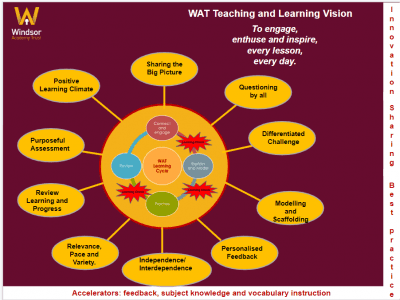Insights into inspirational arts practice in schools: Unlocking academic and personal potential and developing cultural capital through art


Kingswinford Academy is situated in West Dudley, bordering South Staffordshire. It is a good school with above national average progress and attainment year on year. The percentage of students with Pupil PremiumAdditional funding for publicly funded schools in England to is rising due to local changes to demographics with a growing population. Kingswinford is a mixed school. There are currently 727 students on roll between Years 7 and 10, 110 staff members employed at the school, and 24.2% pupil premium. The art department has three members of staff, two of them part-time, and one full-time head of department, who works as a lead practitioner for Windsor Academy Trust across 9 schools (5 primary and 4 secondary) one day a week. One part-time art technician complements the art department.
We are an extremely successful department at Kingswinford Academy, consistently achieving higher than national average results. Art has always been a popular choice for GCSE, offering fine art and photography endorsement. Twenty six years of teaching has allowed me to be at the forefront of quality-first teaching and learning which I consciously placed at the heart of the curriculum, and consequently that has led to my success.
Historically, we were relatively isolated as a school. We were grant-maintained then became an academy converter. The Kingswinford School joined Windsor Academy trust (WAT), consisting of 7000 children and 9 schools, in November 2016 and from the onset we hit the ground running. This became the catalyst for us really starting to thrive.
I was successfully appointed as lead practitioner for the arts across our trust family in September 2017. Within two years, I completed NPQSL and achieved SLE status. Joining the trust allowed my role as a leader within one school to develop into that of a leader across nine schools. I was given clear outcomes to achieve, with the flexibility to use my expertise to accomplish them. These were:
- to provide guidance, support and mentoring to arts leaders in order to improve outcomes and unlock academic potential
- to develop and lead Trust-wide enrichment opportunities that bring students together across the family and unlock personal potential
- to increase cultural capital.
I began working with the primary schools, which reflected our commitment to valuing art across the Trust schools, alongside the obvious national emphasis on English and maths. One of the noticeable differences between primary and secondary was that art was not taught often or as a discrete subject; provisions varied in each school as they joined Windsor Academy Trust. It was not uncommon for a whole term to pass without one art lesson. By that, I mean a single, structured lesson dedicated explicitly to art. There may have been times when students were allowed to draw, but with little structure or guidance. Whilst art displays were vibrant, exciting and visible, I wanted to investigate the intent behind them.
I regularly visited the five primary schools and very quickly a picture emerged of what was needed. Learning walks were conducted and meetings were arranged with art leaders. Staff were extremely open, willing and committed to teaching art but by their own admission, they lacked the confidence, skills and subject knowledge to successfully deliver art lessons. They were eager to be directed and to learn; not just to produce something that looked aesthetically pleasing but to incorporate the skills and techniques that learners needed to develop as artists, and ultimately improve final outcomes.
Creating a broad and balanced art framework from scratch was daunting. But this is where I could really make a difference and employ my subject-specific knowledge and experience. Most teachers don’t have the time to dedicate to developing a comprehensive art curriculum by themselves, and this is where my role across the family made it possible to produce something worthwhile. It needed to have focus, clarity and be easily accessible; giving a structure to something previously unstructured. Ultimately, I wanted it to empower staff.
Working in alignment with the WAT Primary Aspire Curriculum led to the creation of the WAT Primary Art Curriculum – detailed planning for staff to deliver to learners from Years 1 to 6.
WAT Aspire attributes.
The framework covers artists, styles, genres, techniques and skills supported by images, websites links and video clips. A ‘scaffold’ approach is used in the structured design, enabling concepts to be taught whilst building yearly on prior knowledge, revisiting key topics in more depth. At the heart of the planning are the ‘formal art elements’ and the need to explicitly teach art through artists, eras and cultures.
It allows opportunities to develop literacy and includes tier 3 vocabulary as well as containing information on local art galleries, museums and historical places. Equally important was not just developing learners’ skills and confidence but also those of the staff, and this was supported through my delivery of continued professional learning sessions.
Similarly, it was vital to develop the role of art leads within primary schools. This was important in allowing me to lead leaders, enabling them to grow and have the confidence and enthusiasm to promote the subject. Within our family, we consider ourselves to be a learning community as well as a teaching community and for this reason, we are committed to developing a mindset amongst our staff and our learners whereby we all believe that we can be a little bit better.
Impact
Twelve months on, the arts curriculum has been acknowledged as being extremely strong during two OfstedThe Office for Standards in Education, Children’s Services inspections:
‘High-quality fine art is displayed in many corridors and walls around the school.’
‘The wider curriculum is well planned. Pupils enjoy many creative activities such as singing, art, music and dance.’
‘Corridors and classrooms have lively and stimulating displays.’
Art day at Tenterfield primary Academy – Year 1 mark-making with natural and found objects. Year 6 Mad Hatter tea party – tonal skills.
There is an increased focus on whole school art days, culminating in celebrations of skills and outcomes, whilst still having that vital link to literacy; the increase in tier 3 vocabulary on display; the way teachers talk about art, the skills being taught and the enthusiasm from the primary staff is a joy to see. The impact can be seen physically through the use of sketchbooks from Year 1 onwards; what better way for a learner to gain confidence by seeing conclusive proof of the progress they have made.
Staff and learners are able to talk about their journey and the process of creating their artwork. They focus on the intention and the skills behind it. The celebration of collaboration between subjects for a purpose. There is an increased pride in the work accomplished by all stakeholders.
Guidance and support is the focus for the four secondary schools, ensuring consistency and high standards are maintained through a rich knowledge based curriculum. I have lead the development of the Art curriculum, working collaboratively with art departments within the trust schools, to develop ‘threshold concepts’ to support the WAT Curriculum Framework.
The Year 7 and 8 curriculum provides the foundation for academic success in examinations. The curriculum framework consists of the following:
- Threshold concepts. These define potentially powerful transformative points in the student’s learning experience. They are the ‘jewels in the curriculum’ because they identify key areas that need mastery. Until students ‘get them’, they can struggle to understand a subject.
- Mastery/Deep learning. We believe that the route to deep learning and the development of expertise and mastery is to do fewer things in greater depth. Threshold Concepts are mastered through repeated sequencing that allows the student to apply threshold concepts in different contexts.
- Long term memory and sequencing.
- Challenge. The provision of difficult work that causes students to think deeply and engage in healthy struggle – a high challenge, low risk culture is created.
- Tier 2 and 3 vocabulary.
- Character. The Windsor Academy Trust ASPIRE character framework identifies fourteen character virtues that are explicitly taught through the curriculum.
Year 9 bridging curriculum
The year 9 curriculum bridges the gap from the threshold curriculum in years 7 and 8 and GCSE preparation. The bridging curriculum acts as a platform to prepare students for success in Key Stage 4 national qualifications.
Implementation
Our curriculum intent will be implemented through ‘engaging, enthusing and inspiring every lesson, every day.’ Our WAT teaching and learning cycle, through which our ten teaching and learning principles are embedded, ensures that the curriculum is delivered effectively so that all students make progress regardless of background and ability.
Teaching and learning sits at the heart of our trust family. Our vision for teaching and learning is to engage, enthuse and inspire every lesson, every day. We share a common vision, a common language and a common framework.

Another essential focus was to increase cultural capital and unlock personal potential not just through the teaching of the arts curriculum but also explicitly to raise aspirations, enabling social mobility and creating happy and successful learners by supporting visits to galleries and museums from KS1 to KS5.
Raising the profile of art across the family is crucial and this has grown with an annual trust-wide art competition. This year, I received over 600 entries, which culminated in two ‘excellence in arts’ events, celebrating art, dance, drama and music with performances across all key stages and an exhibition of artwork, including the winners.
Being part of the trust has opened up so many opportunities for me to develop as a leader and share my passion and expertise for art pedagogy. I will continue to motivate, challenge and inspire colleagues to provide outstanding art provision for our learners leading to exceptional outcomes.









